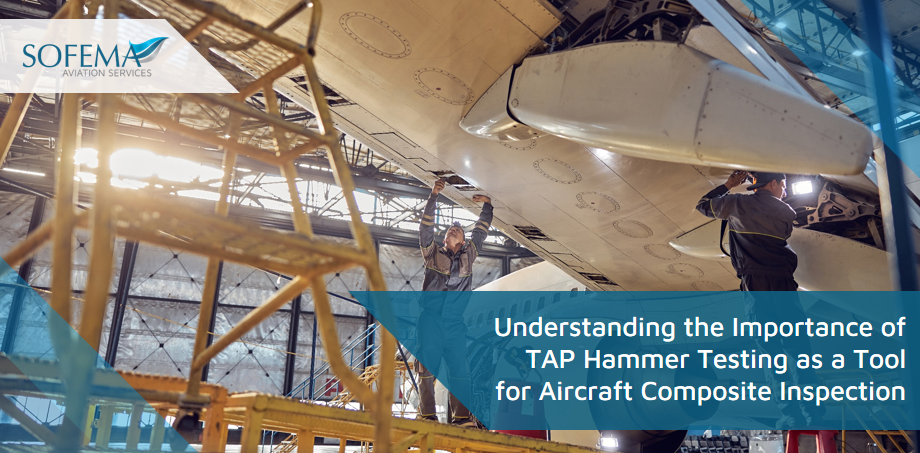Sofema Aviation Services (SAS) www.sassofia.com considers Best Practices and Challenges related to Composite Material TAP Hammer Testing. To provide the most effective inspection requires a competent Inspector who can provide the skill level necessary to support the task.
Introduction
Composite materials, such as carbon fibre-reinforced polymers (CFRP), are increasingly used in modern aircraft due to their high strength-to-weight ratio. However, these materials can be susceptible to hidden internal defects or delamination that may compromise their structural integrity.
Composite structures can experience damage or delamination that is not immediately visible on the surface. TAP Hammer testing allows inspectors to detect internal defects by using acoustic waves to assess the integrity of the composite structure.
- By tapping the surface with a specially designed hammer and analyzing the resulting acoustic response, inconsistencies or anomalies in the material can be detected.
The time required to perform TAP testing depends on various factors, including the size and complexity of the composite structure, the number of inspection points, and the skill level of the technician.
TAP Hammer testing can be performed in the field, making it suitable for on-site inspections. This is particularly advantageous in aircraft maintenance, as it allows for inspections to be carried out without the need for disassembling the aircraft or sending components to specialized testing facilities. It provides a convenient and efficient means of assessing the structural integrity of composite materials in real-world conditions.
TAP testing is a relatively quick inspection method compared to more time-consuming techniques like ultrasonic testing or X-ray inspection. However, the actual time required can vary significantly and should be considered in the overall inspection schedule.
- This non-destructive testing method involves striking the surface of the composite material with a hammer-like device and listening to the resulting sound and vibrations to assess the integrity of the structure.
- Understanding the importance of TAP testing requires considering the skill level required, best practices, challenges involved, and the time required to perform the task.
Skill Level
- TAP testing requires skilled technicians who have undergone specialized training and demonstrated competence to the required standard.
- They should have a thorough understanding of the composite materials used in aircraft structures, as well as the expected acoustic responses and typical defects encountered.
- This expertise enables them to interpret the sounds and vibrations generated during the TAP testing accurately.
Best Practices
- Technicians should adhere to established procedures and guidelines specific to the aircraft and composite materials being inspected.
– Standardization helps maintain consistency and reliability in the inspection process. - The composite surface should be prepared adequately by removing any coatings, paint, or contaminants that could affect the acoustic response during tapping. A clean and smooth surface facilitates the accurate detection of defects.
- Technicians need to apply consistent tapping force and use a standardized tapping instrument to strike the composite surface.
– This ensures uniformity and comparability of the acoustic responses, enabling reliable defect detection. - The entire composite structure should be systematically inspected using a grid pattern or predetermined inspection points to cover the entire surface area. This approach ensures comprehensive coverage and minimizes the risk of missing potential defects.
Challenges
- Subjectivity: The interpretation of the sounds and vibrations produced during TAP testing requires experience and expertise.
– Technicians must distinguish between normal acoustic responses and indications of defects accurately. This subjectivity introduces a level of variability that can affect the reliability of the inspection results. - External factors, such as temperature, humidity, and noise, can influence the acoustic response during TAP testing.
– Technicians should account for these variables and mitigate their impact as much as possible to ensure accurate defect detection. - Composite structures can have variations in thickness, curvature, and construction, leading to different acoustic responses.
– Technicians need to be aware of these variations and adapt their inspection techniques accordingly.
Next Steps
Follow this link to our Library to find & download related documents for Free.
Sofema Aviation Services – provides regulatory training and consultancy regarding the best practices and challenges related to composite material TAP testing – please see the website or email team@sassofia.com
Tags:
Aircraft Inspection, SAS blogs, Aircraft Inspection Standards, Aircraft Technicians, best practices, TAP Testing, Composite Materials, Carbon Fibre-Reinforced Polymers (CFRP), TAP Hammer, Aircraft Composite Inspection





